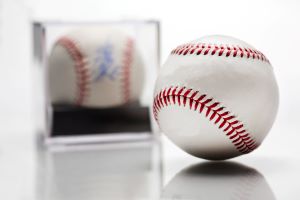
Although the pandemic shuttered many brick-and-mortar sports collectible shops, the value of the U.S. sports memorabilia remains healthy and robust, estimated at $5.4 billion annually. Noteworthy sales over the past three years like the original Olympic Games Manifesto ($8.8 million), Babe Ruth’s jersey ($5.64 million), and Dr. James Naismith’s 1891 Rules of Basketball ($4 million) testify to the enduring value of the sports memorabilia market.
Like all collectibles, sports memorabilia must be preserved in as pristine condition as possible, to retain their financial worth and increase in value in the years ahead. Another asset risk is a concerning volume of counterfeit products, with at least 50 percent of vintage sports memorabilia discovered to be forged or reproduced to look like the real thing.
Assuming these risks are managed and collections are insured, there may be no better time to jump on the sports collectible bandwagon. Rookie collectors and even veterans have an opportunity to diversify their investment assets with objects that often resonate personally. As my collector friends tell me, half the fun is the treasure hunt—finding a prized baseball bat, Wayne Gretzky’s rookie hockey card or a Kobe Bryant autograph.
The pursuit of these passions requires knowledge and expertise to ensure the purchase of authentic items at realistic market prices. eBay is the industry’s major conduit, although sports memorabilia conventions and local collectible shops still play a large role. Upon finding an item of interest, collectors should ask for appraisals, grading and authenticity documents.
If you aren’t in the market for top-tier treasures like Hall of Fame shortstop Honus Wagner’s baseball card ($6.6 million) or Michael Jordan’s signature 1985 Nike Air Jordans ($560,000), opportunities exist to find tomorrow’s star players on local college sports teams or an alma mater’s athletics program, offering the chance to secure an autograph in the initial innings of their careers.
Athletes are permitted by the NCAA and federal and state laws to monetize their name, image and likeness, and some players have already inked contracts for autographs and merchandise. Imagine securing Tom Brady’s autograph in his college days, before he became, well, Tom Brady.
Once you’ve scored a prized autograph or a vintage sports card or jersey, the focus shifts to preservation and risk transfer. A key asset risk consideration is sunlight, as signature inks and fabric dyes may irreversibly fade from extended UV exposure. By keeping objects away from sunshine and drawing the shades when showing off or displaying sports memorabilia, both their look and value will be safeguarded.
Variations in temperature and humidity are another important risk consideration, as the fluctuations can irrevocably damage collectibles made from paper, leather and metal. Additional smart tips include the use of custom card holders and to never laminate sports cards, which reduces their value.
What else? Whether your collection is an investment, a passionate pursuit or a bit of both, limit handling the items, as it can cause subtle wear and tear. And keep your collection out of the basement, due to the risk of water damage from a leak or clogged drain, which are not designed to store valuable assets.
Now that you’re warmed up, covering all the bases and are ready to play, speak to an insurance agent or broker about insurance coverages. Then rest easy, since the treasure hunt is the best part anyway (a return on the investment is just a bonus). After all, the word “memorabilia” is derived from the Latin phrase “things to be remembered.” Like much in life, it’s the memories that count.
Matt Davis is a Risk Consultant with Chubb Personal Risk Services.
The opinions and positions expressed are the authors’ own and not those of Chubb. The information and/ or data provided herein is for informational purposes only and is not a substitute for professional advice. Insurance coverage is subject to the language of the policies as issued.